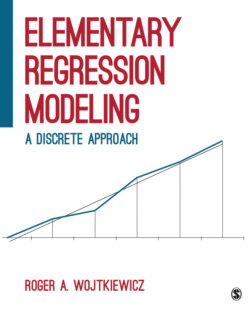Читать книгу Elementary Regression Modeling - Roger A. Wojtkiewicz - Страница 29
На сайте Литреса книга снята с продажи.
Examples of Means and Log Odds
ОглавлениеThe respondents in the High School Longitudinal Study took achievement tests for mathematics when they were juniors in high school in 2012 as part of the first follow-up of respondents in the study. The math score for each student was standardized to a national mean of 50. The result was a mean standardized math score of 50 for the total sample.
The mean for each subgroup is calculated by summing scores in each subgroup and dividing that sum by the subgroup total. The data show that students attending private school scored higher in math than students in public schools, 55.86 compared with 50.80. Note that the mean for the total is not 50. This occurs because some members of the original sample were not included in the analytical sample as a result of missing data. Those respondents who had scores less than 50 were overrepresented among the respondents who were excluded from the working sample as a result of missing data, and this led to a sample mean of greater than 50.
Table 2.2 shows a frequency cross-tabulation for those in public and private schools for whether the respondent was in the top 25% on math score. Thus, the top 25% variable is a dichotomous or two-category variable that involves dividing the sample respondents into the top 25% or not top 25% in math score.
The proportion converts frequencies into numbers that are relative rather than absolute. The proportion in the top 25% on math score is higher for those in private schools compared with those in public schools, a .39 proportion for private compared with .22 for public.
Table 2.2
Table 2.3
Table 2.4
For those in private schools, 39% were in the top 25% on math score compared with 22% for those in public schools. Those in private are more likely to be in the top 25% than those in public.
The odds calculation for public was 3,730/13,067 = .28. The odds compares a frequency f with its complement N − f. Odds less than 1.00 indicate the f is less than N − f, whereas odds greater than 1.00 indicate that f is greater than N − f. For those in private schools, the odds of being in the top 25% on math score was .63 compared with an odds of .28 for those in public schools. This result also indicates that students in private school are more likely to be in the top 25% than those in public.
Table 2.5
The log odds calculation for those in public school is ln(3,730/13,067) = −1.25. The log odds compares a frequency f with N − f in logarithmic terms to the base e. Log odds less than .00 indicates that f is less than N − f, whereas log odds greater than .00 indicates that f is greater than N − f. A log odds of .00 indicates that f equals N − f. One advantage of the log odds compared with the proportion and the odds is that the log odds does not have a predefined lower limit or upper limit. The proportion ranges from 0.0 to 1.0, and the odds ranges from 0.0 to infinity. The log odds ranges from infinitely negative to infinitely positive. Note that the ln(0.0) is not defined mathematically.
The log odds will show the same relationship between two groups as the percentages. The percentage in the top 25% on math score is higher for those in private school compared with those in public school, 39 compared with 22. Likewise, those in private school had a higher log odds of being in the top 25% on math score than those in public school, −.45 compared with −1.25.
Table 2.6
